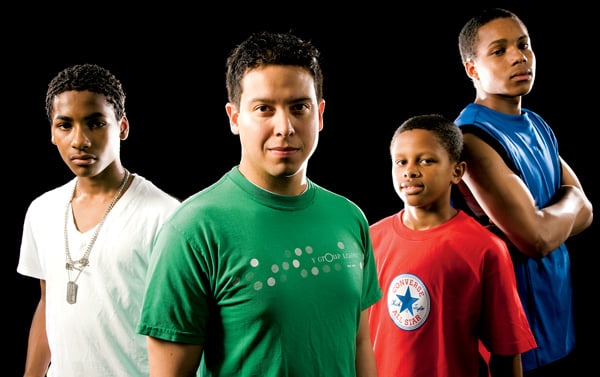For the first time in months, I have their attention. My audience: six African-American boys, ages 13 to 17, from my church.
For the last six months my wife, Hilary, has struggled to keep them focused in Sunday school while I’ve struggled to connect with them in youth-group meetings. Now, at the end of a self-defense tutorial, they’re hanging on every word.
It’s Thursday night, and we’ve just finished tonight’s combo: jab, cross, clinch, knee strike, shoulder throw, knee drop, and ground and pound. The boys pull off the final moves in slow motion, throwing their partners to their backs, kneeling on their stomachs, and preparing to throw a flurry of punches to the face. I conclude the lesson by saying, “And you keep hitting him until he stops moving.”
Andre, one of the younger kids, asks, “Should we really hit him until he stops moving?”
I realize that the finishing move hardly seems defensive. I talk with them about when it’s appropriate to fight and what is appropriate in a fight.
“You can solve 99.9 percent of your problems without using violence,” I say. “But when you do have to fight, you don’t want to get hurt. The best way to do that is to hurt your opponent quickly and severely and end the fight as soon as possible.”
They look to me as the expert. Street fighting isn’t official curriculum, but in the Church of Jesus Christ of Latter-day Saints, every member of the ward—or congregation—is expected to help and teach every other member. Doing that is simple in theory, but among people of such different backgrounds, it sometimes seems impossible.
My wife is the daughter of a lawyer; I’m the son of a doctor. We’re both from small towns, we met in college, we moved to Capitol Hill for work and adventure. The teens are all from working-class families in Trinidad and Benning Heights—the outermost boundaries of our church’s Capitol Hill ward.
Fourteen-year-old Isaiah was unofficially adopted by one of the church members. A few years ago, he had to identify his older brother’s body. That would have been hard for anyone; Isaiah’s experience was made worse by 11 gunshot wounds to his brother’s face.
Some of the others have similar stories. Considering their accumulated life experience, their hardships, and the speed at which they’ve had to grow up, I can understand why they might doubt we have anything to teach them. Joe, Isaiah’s adoptive brother, is too cynical, too cool, and too strong to turn to an outsider like me for guidance.
But that night we all made a connection. I’d gotten into a few fistfights in middle school. I’d taken some jujitsu classes in college. And perhaps for no other reason than testosterone, we were all able to bond over a self-defense lesson.
I wrapped up my speech: “Any time you fight, you’re not showing what a man you are. You’re showing that you weren’t smart enough to solve the problem any other way. Don’t fight unless you have to.”
The class over, the boys gathered in the next room, hoping for some food left over from the girls’ activity. A few kept practicing the shoulder throw, maybe to master it, maybe to show off. That Sunday at church, Joe asked for my phone number, just in case he needed help with his algebra.
Have something to say about this article? Send your thoughts to editorial@washingtonian.com, and your comment could appear in our next issue.
This article appears in the August 2008 issue of Washingtonian. To see more articles in this issue, click here.
















